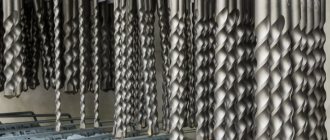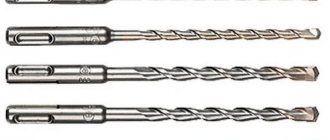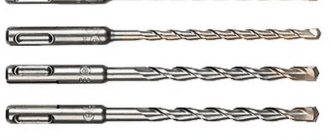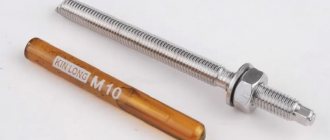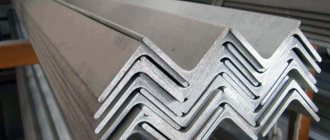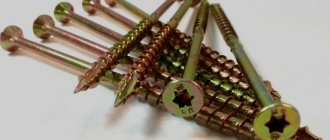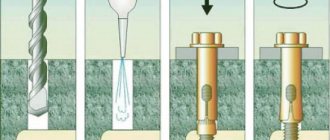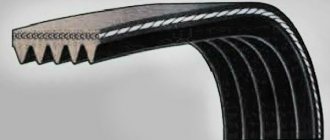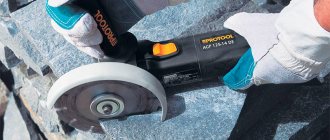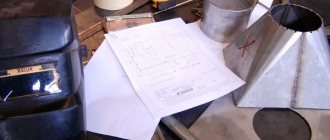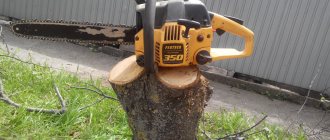A hammer drill is an equipment used to make holes in the structure of dense materials (stone, concrete, brick, reinforced concrete). Applicability and quality depend on the type of product, material and design features, which we will discuss further.
Choosing a concrete drill for a rotary hammer Source stroevod.ru
Device
Regardless of the above-mentioned type, material and design features, drills for concrete hammer drills are built according to a standard principle. They are actually built from two parts: the shank and the working part. The latter, in turn, consists of 4 more zones:
- Spirals - spiral-shaped turns that help remove dust generated during the drilling process.
- The core is the main rod on which spiral-shaped turns and cavities are organized that remove dust.
- Channels for dust removal - peculiar cavities obtained due to the ribs of the spiral.
- The carbide cutting edge is the tip of the drill, which bears the main load during drilling. The effectiveness of work and the durability of the equipment depend on its quality characteristics.
How a drill for a hammer drill works Source redteh.ru
Important! When choosing a good concrete drill, pay attention to the location of the cutting plate. It should “sit” firmly in the saddle and be located strictly in the center.
What is the difference between a drill and a concrete drill?
A standard drill bit for impact drills/drivers for concrete has the following differences from a drill:
- Shank type. In drills for SDS-Plus and SDS-Max drills, in drills - cylindrical. The shank has grooves where it is installed in the socket: they provide greater reliability.
- Strength and durability. The power of a rotary hammer is higher than that of a drill. During the drilling process (drilling with impact), the equipment performs reciprocating movements: they are subjected to strong shock loads, therefore they are additionally reinforced: wear resistance is higher.
- The presence of a screw rod at the nozzles allows the resulting dust and waste to be removed from the hole simultaneously with drilling.
Most models of drilling tools have 3 operating modes:
- Drilling.
- Chiseling.
- Impact drilling.
Drill bits for hammer drills
Yandex.RTB RA-1479455-3
Each is focused on specific types of investments. The first rotates the tool in the chuck, the second makes reciprocating movements (for example, a chisel works in this mode), the third combines the actions of the first two.
Drills for drills and screwdrivers are designed for non-impact drilling, therefore they are equipped with a smaller safety margin.
Labeling and classification
The main marking of drills takes place with an eye to the size of the equipment. The indicator is determined by its purpose: to obtain a through hole, a recess for an anchor or a thin dowel-nail. Based on the specifics of requests, generally accepted marking is carried out.
- Total length.
- Diameter.
- Shank type.
Healthy! An example of marking a drill with an SDS-plus shank 210 mm long, 10 mm in diameter: 10x210, SDS-plus. According to this principle, all equipment is “read” not only for rotary hammers, but also for drills.
The best companies and prices
Chinese drill “Ermak” - reliability and quality make it possible to use it in domestic conditions.
Reliable suppliers include a number of European, Japanese and American companies, for example:
- Alpen (Austria);
- Drebo (Germany);
- Diager (France);
- Bosch (Germany);
Among domestic productions, we can highlight products under the Zubr brand, the range of which includes household, semi- and professional products.
Due to the unstable economic situation in the world and our country, only approximate prices can be indicated:
- Short drills Ø 6-10 mm with a working part up to 50 mm cost 45-115 rubles/piece.
- An average tool Ø 6-12 mm, length up to 160 mm fits into the price of up to 150 rubles/piece.
- Branded products or those with larger sizes have prices starting from 200 rubles/piece.
Shank type
Shanks on drills are classified according to external characteristics. Unlike drill bits, their dimensions are not affected by the diameter and length of the equipment, which allows them to be used with any hammer drills with a suitable type of chuck.
Popular shank for concrete drills Source uainfo.com
We will consider only those that can be encountered in everyday life, that is, applicable to modern rotary hammers. They bear the general name SDS, which is further divided into several categories.
SDS is the first model that served as a prototype for all modern equipment for this purpose. It has a diameter of 10 mm and 2 channels, ensuring reliable contact with the torque of the chuck. It goes in only 4 cm deep.
SDS-plus is the most popular group. With a diameter of only 10 mm, it deepens into the cartridge by 4 cm. The advantage and difference from the founder of the group, the SDS shank, lies in the twofold superiority in the number of recesses. There are 2 closed and 2 open channels. The latter here work as guides, while the closed ones play the role of a stopper and are intended for locking bearings. The area in contact with the wedges is only 75 mm2.
The main segment with which such equipment is used is household and professional small-sized hammer drills (lightweight). The diameter of the drills varies from 4 to 26 mm, and the length from 110 to 1,000 mm.
What is the difference between SDS-max and SDS-plus Source ferrocom-ekb.ru
Healthy! SDS and SDS-plus shanks are completely interchangeable
SDS-max is an equally popular drill shank. Belongs to the category of equipment for large tools. The element has a seat diameter of 18 mm, and the surface of the contacting wedges is 389 mm2. It has 5 grooves, 3 of them are open, 3 are closed. As already mentioned, the size of the tool with which such drills are used is fundamentally different from household equipment and is used in industry and large-scale construction. Only in a chuck this type of shank fits 9 cm.
The most popular types of concrete drill shanks Source detaltorg.ru
How to choose drills for a hammer drill. Crowns, chisels and other attachments
5/5 — (1 vote)
Properly selected tool accessories are half the success of the work done, and attachments for rotary hammers are no exception. Poor-quality or improperly used hammer drills can have a detrimental effect on the quality of work and the safety of the tool. Therefore, after reading this article, you will not make a mistake, and a positive result will not be long in coming.
Of course, the main purpose of a hammer drill is to work with concrete, stone and brick, but if the tool has certain modes and special attachments are used, then it is quite possible to go into the “element” of wood and metal.
Equipment fastening system.
Currently, the most common mounting system on a rotary hammer is the “SDS” system, which in turn is divided into two types: SDS-Plus and SDS-Max. It was invented, patented and put into operation by Bosch, and is now used on the vast majority of rotary hammers. The essence of this fastening is in special slots on the chuck and the shank of the equipment, which are rigidly fixed to each other and clamped by a skirt on the chuck. Light hammer drills are equipped only with the SDS Plus system, heavy SDS Max, the middle class can be found with one of these types.
Hammer drills have shanks that should be lubricated with a special graphite lubricant before being inserted into the chuck. Further, during operation, the lubricant spreads throughout the shank and the rubbing part of the cartridge. This mandatory procedure will significantly increase the service life of the cartridge and equipment.
Accessories for rotary hammers.
Drill bits for hammer drills
with the use of impact drilling in concrete, brick and stone - this is the most popular and necessary attachment. It is a consumable item and is used on a hammer drill in hammer drilling mode. This makes this analogue of a concrete drill much more effective than its “brother”. There are some differences in drill design that are worth noting.
The most popular sizes used in everyday life are drills with a diameter of 6, 8 and 10 mm. In professional activities, a wide variety of sizes, both in length and diameter, can be used. When purchasing this nozzle, you should pay attention to the quality. By the way, this will be hinted at by the noble color and markings on the body of the drill. More on this a little later.
At the moment there are a huge number of manufacturers. The most famous of them, proven by craftsmen and time, are Bosch, Metabo, D*Bor, DeWalt, Hilti. Among budget manufacturers, users note Zubr and Praktika.
Type based on the number of cutters on the solder and spirals on the body of the drill | |
| double helix | 1) single-shaped carbide tip for precise drilling and long-lasting performance; 2) a narrow chisel-shaped tip increases the speed of drilling small diameters; 3) a single spiral extending from the tip along the body of the drill effectively removes waste material from the hole, which increases the drilling speed; 4) the load on the drill is balanced, which reduces friction and vibration. |
| 4 spirals | 1) a solid X-shaped soldering flows into 4 separate spirals along the body of the drill, has an excellent service life and good performance; 2) this form of carbide brazing allows you to drill into material with reinforcement, when another drill can jam or twist the head; 3) during operation, harmful vibrations are reduced, which increases the life of the drill and dampens the vibration of the nozzle; 4) high drilling precision. |
It is worth noting that hammer drills with four spirals are optimal for professional use. Only at the same time it is more expensive compared to double drills. A double helix will work more efficiently when drilling small diameters; it is more often used in the SDS-Plus system. The four-spiral type is more often used in the SDS-Max system and is optimal for impact drilling large holes in strong materials, including those with reinforcement.
If there is a need to use SDS-Plus drills, and the chuck is installed SDS-Max, then you can use an adapter from Max to Plus. There is no return adapter.
Drills for hammer drills, as stated above, have a variety of sizes (diameter and length). When drilling with long drills of large diameter, you should initially go through the hole with a smaller drill. This is necessary to reduce the load on the body of the drill and, most importantly, on its shank.
| working length | drill diameter | |
| SDS-Plus | 50-950 mm | 4-32 mm |
| SDS-Max | 200-860 mm | 12-55 mm |
Chisels
are auxiliary equipment for a hammer drill, which are used when it has a third mode - chiselling.
They have a number of varieties in shape and purpose. A sharp peak-shaped chisel (a) is used for dismantling brickwork and gouging out various holes, for example for mounting boxes. A flat chisel (b) is suitable for leveling the surface and knocking out material from the finished groove. A wide chisel (c) is more convenient to use for beating tiles, porcelain stoneware and plaster. The groove chisel (d) is adapted for gouging out grooves during electrical installation.
When working with chisels, the operator requires some effort to enter in the desired direction. In this case, there is no need to press too hard, the process will not go much faster, and the load on the engine and the hammer drill mechanism as a whole will be unnecessary. The overall length of these nozzles comes in many sizes. So in the SDS-Plus system it is usually 250 mm. If it is longer, then a critical load on the chisel shank is likely. The SDS-Max system has a total length range from 300 to 600 mm.
Carbide bits
for hammer drills are designed for impact drilling of round holes of large diameter in brick, stone and unreinforced concrete, for example for mounting boxes. They are a metal glass, with a centering drill for concrete and carbide tips on the outer cutting edge.
If necessary, impact drilling of through holes for laying pipes, including deep ones (with extensions), is permissible. The universal standard thread allows you to install any crown on the extension. The main thing is that the potential of the hammer drill is designed for this.
Diamond crowns
for a hammer drill they are a metal cup with a cutting edge, which in turn is made not of carbide tipped, but of industrial diamond sputtering. The design provides for the possible presence of a centering drill.
A similar, to put it mildly expensive, attachment for a hammer drill is indispensable when drilling the most durable materials. There are specimens that are capable of drilling a strong monolith with reinforcement. A diamond bit is used on a hammer drill in drilling mode without impact! The main advantage of such a crown is its high wear resistance; the holes are almost perfectly straight, which is important for precision work. This is why professionals use a diamond crown, for example, for laying socket boxes (standard diameter 68 mm).
We must not forget that diamond spraying varies in hardness; the hard matrix (T) has an increased resource and will wear out longer than spraying diamond chips with a soft binder (M). For reinforced concrete, options with polycrystalline diamonds are suitable, some fractions of which can be replaced over time according to the degree of wear.
Let's note a couple of important rules:
- When working with a crown, especially a diamond one, it is worth considering the level of load on the hammer drill so that this does not become his last work shift. Drilling concrete is a very labor-intensive process in itself, especially if you need to drill a large and deep hole. In such cases, it is better to use a more powerful hammer drill, and preferably with an SDS-Max system.
- It would not be superfluous to wet the working part of the bit and the hole itself with water, especially when diamond drilling without impact, in order to minimize heating of the nozzle and facilitate its entry into the material.
Other types of adapters and attachments
involves using a hammer drill like a powerful drill. Therefore, the most common approach is to switch from the SDS system to a conventional chuck like an electric drill or cordless screwdriver. There are two ways to do this:
The hammer drill is initially equipped with an additional quick-release chuck, which is installed instead of the standard SDS chuck and does not create an additional connection. A very convenient and practical solution, but this option significantly increases the cost.
An adapter with a left-hand thread is fastened into the SDS chuck, onto which a regular chuck is screwed. This creates an additional connection and makes the tool bulky, which is not very convenient during the drilling process.
There are adapters from the SDS system directly to an adapter for bits and even to a standard square for heads (1/4, 3/8, ½). It is even rarer to find accessories not intended for “perfing” with a standard shank, be it a mixing attachment or screw drills.
Working with any attachment from this section must be carried out in drilling mode without impact, otherwise the impact mechanism on the hammer drill will simply break any of them that is not designed for this. It is worth noting that these adapters are intended for light and medium class “perfs”. On heavy machines, using them is completely inconvenient and impractical.
Quality and manufacturers.
The main indicators are wear resistance and performance. A good drill or crown will be enough for a larger number of holes, and a spatula or chisel will not become dull longer. This depends on several factors:
- The quality of the raw materials from which the equipment is made.
- Precise technical design of the nozzle, which should not be crooked, play during operation, etc.
- Thermal stability, the longer the drill does not heat up, the longer it can be drilled.
- Speed of cuttings removal, especially with long drills and bits.
We will not ignore the numerous manufacturers of drills and other accessories for hammer drills. Often their quality is determined by the status of a particular company. Some have proven themselves to be the best, while others have negative user reviews.
So how do you know which is better and which is worse? After all, everyone praises their own, and you can write whatever you want in the recommendation of your product, but this is how it will happen in reality! Basically, such knowledge is achieved through trial and error, but if there is no time and money for this, we will distinguish two categories:
Professional equipment
designed for drilling and chipping the hardest material and will last many times longer, but at the same time has a high cost. Of course, such items pay for themselves in any case, so they are popular not only among professionals, but also among the average home craftsman.
Site rating: professional drills and equipment | ||
| 1. | Bosch | A huge range of all types and sizes, equipment of excellent German quality. Excellent performance and high market availability. |
| 2. | PROJAHN | Another German manufacturer, long service life and a decent range, especially for drill bits and breakout drills. |
| 3. | HILTI | Extremely positive reviews from professionals, let down only by the very high price and poor distribution in our market |
Budget (household) class equipment
do not have high wear resistance. They are more affordable and a good option. For example, if you need to drill several holes, and also if the material is not the strongest.
Site rating: budget drills for rotary hammers | ||
| 1. | Practice | This company is becoming more and more popular. Excellent performance at an affordable price, making them in demand even among professionals. |
| 2. | HAMMER | Chinese equipment with a German name, cheap and cheerful. A good option for home use |
| 3. | Information | Quite a good product for the money. Quite a “tenacious” equipment, the only thing is that the productivity is not the highest. |
So, when choosing a drill, crown or chisel, always take into account what material you will have to deal with. After all, even concrete is divided into strength classes. If you need to make a hole in strong marble, a simple cheap drill will do no good, it will just be a waste of money, it is better to purchase an expensive, but high-quality option. And don’t forget about safety precautions and good work to you!
0 0 votes
Article rating
Working part
As already mentioned, the middle (helical) part of the drill is responsible for the timely removal of dust from the hole. It can be manufactured in different designs, and accordingly it will be classified differently.
- Classic auger drill - designed for drilling deep holes. Due to the optimally selected spiral design and nominal rotation speed, it effectively removes dust. This reduces the load on the tool and the time spent on performing a specific task.
- Small angle of inclination - used with a tool that has low impact inertia. The optimal purpose is to obtain a large number of holes, small in size (with a diameter of no more than 10 mm, a depth of up to 800 mm).
- Large inclination angle - such equipment has an excellent dust removal rate, which affects drilling performance. Designed for drilling through and non-through holes. However, the optimal effect is achieved by obtaining a single hole of large diameter and depth.
What tool is needed to do the work?
So, we have figured out the factors influencing the resource, now let's figure out how many drills we will need to make 10,000 holes in 20 mm thick granite.
Not all granites are drilled the same way; they may differ in hardness, abrasiveness and viscosity, therefore the life of a diamond drill may differ for different granites.
Micro-impacts also affect the life of the drill - when the drill just enters the surface of the material. Therefore, use template suction cups while working. If such a template is not at hand, you can make it from improvised materials. For example, you can use the same material for a template, having previously drilled a hole in it, and you can secure such a template using clamps, placing a piece of wood between the jaws so as not to damage the polished surface of the granite.
For the operation of sintered diamond drills, an abundant supply of water is required; if there is no water or there is not enough water, the cutting part of the drill begins to overheat and, as a result, collapse. Often they bring us drills, which on average should go through about 80-100 holes, and they say that the drill went through only 10 holes, and in 90% of cases, it turns out that they drilled without water.
Tip
Different types of metals are used in the manufacture of equipment. For example, alloy tool steel is used in the production of the rod and shank. For the cutting element (tip), pobedit or diamond brazing is used. This allows not only to significantly increase the service life of the equipment, but also has a positive effect on its productivity.
The peculiarity of drilling holes in concrete with a hammer drill, when compared with working with conventional drills, is that the degree of sharpening does not matter here. As a result of dulling, performance decreases, but not significantly. The main factor in this situation is the solder size. As soon as its width becomes less than the diameter of the drill rod, problems will arise with the subsequent installation of the anchor or dowel-nail plug.
Important! The diameter of the hole will correspond to the size of the drill only if the nozzle is not ground off by 70 percent or more.
Nozzle material
As already mentioned, the tip of a concrete drill can be made in the form of pobedit or diamond brazing. They differ from each other in many ways, from chemical composition to operational characteristics.
Drilling recommendations
Mid-priced pobedite drills provide fairly accurate drilling, but have a limited service life
Among concrete drills from domestic manufacturers and companies from the CIS countries and China, we should highlight products manufactured under the following brands:
Particularly noteworthy is the tool from Bosch, which is distinguished by its four-spiral design, which allows it to easily remove processing waste from the hole being formed.
In the list of foreign companies that offer consumers high-quality concrete drills, the following manufacturers should be highlighted:
. material " drill"
“, that is, I need to take, in addition to the price, the material from the price tag -
diamond annular
drill » The drill
is not taken into account in the price; its
consumption
must be taken according to the design data.
Yes, diamond core drills
are not very cheap.
. drilling holes in steel profile pipes, since there are more than 2000 of them (holes). Drilling in the workshop with a hand drill. And will this price include expenses?
on materials (
drills
). Holes with a diameter of up to 10 mm. Thank you.
. annular diamond drills
according to NPRM 46. Moreover, in reinforced concrete you can get to the reinforcement.
If the reinforced concrete reinforcement is thick (FER46-03-002-19), then drill
consumption are taken into account in the prices. Look.
Author: MMR. of drills separately to the price of Fer46-03-014-03?
, Boers?
Because are they not included in the price or are they included in the invoice size? expenses
?
. take in addition to the price, the material from the price tag - drill
diamond ring?
The cost is simply high for my diameter " Consumption
of diamond annular
drills consumption
(NPRM) Collection 46 "Works during the reconstruction of buildings and structures."
Usage
The thicker and longer the drilling element, the more powerful the hammer drill is needed to operate it.
Manufacturers, as a rule, enter the maximum permissible dimensions of drilling attachments into the passport data of their products; for example, for a 500 W unit, an 18 mm attachment will be the limit of possibilities.
An engine that is not powerful enough will simply not be able to provide adequate performance and will quickly fail.
The supplier also indicates in what speed mode the device can be used. You should not overload a rotary hammer for continuous operation; you need to stop it approximately every 10-15 seconds so that the device does not overheat, especially for inexpensive equipment.
When installing, it is necessary to lubricate the drill bit shank with special oil, which will reduce wear. The drilling axis must be maintained, otherwise the drill may simply break.
If you plan to punch holes in reinforced concrete, you can choose a drill with diamond coating and a design adapted for this purpose.
Some manufacturers have made it possible to “transplant” the chuck from a large hammer drill to a medium one in order to make the tools more versatile, but we remind you that they should not be subjected to excessive load.
